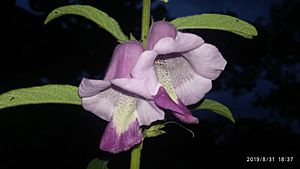Sesamum radiatum facts for kids
Quick facts for kids Sesamum radiatum |
|
|---|---|
 |
|
| Benniseed flowers | |
| Scientific classification | |
| Genus: |
Sesamum
|
| Species: |
radiatum
|
| Synonyms | |
|
|
Sesamum radiatum is a type of flowering plant. It belongs to the Pedaliaceae family, just like the well-known sesame plant. People call it by many names, including benniseed, black benniseed, black sesame, and vegetable sesame. This plant originally comes from west and central Africa. People there have grown it for a very long time. It is also found in some parts of tropical Asia, where it has started to grow naturally.
Contents
What's in a Name?
The Meaning of Benniseed
The name benniseed is a mix of two words: benne and seed. The word benne means sesame. It comes from the Gullah word benne, which is similar to the Malinke word bĕne.
How People Use Benniseed
Benniseed in the Kitchen
Benniseed is a very useful plant for food. People eat the seeds whole, or they grind them into a powder. Sometimes, the seeds are made into a thick paste. A high-quality oil can also be pressed from the seeds.
The leaves of the benniseed plant are also eaten. They can be eaten fresh or cooked. In Sub-Saharan Africa, they are a popular leaf vegetable. When cooked, the leaves become a bit slimy, which is called mucilaginous. The young shoots of the plant can also be eaten. They are often added to soups and porridges.
Benniseed for Health
Besides food, the leaves of benniseed are used in traditional medicine. They can act as a laxative, which helps with digestion. People have also used them as an antidote for scorpion venom. They are also used to help treat sprains and assist with certain body processes. The stem and bark of the plant are known to have properties that fight bacteria.
Growing Benniseed
Plant Description
Benniseed is an annual herb. This means it grows and completes its life cycle in one year. It can grow quite tall, reaching about 1.2 to 1.5 meters (4 to 5 feet) high. Its leaves grow opposite each other, or sometimes they alternate near the top of the plant. The leaves are shaped like a spear or an oval. They can be up to 12 centimeters (about 5 inches) long. Their edges can be smooth or have small teeth.
Flowers and Fruit
The flowers of the benniseed plant grow one by one where the leaves meet the stem. They are usually pink or purple, but sometimes they can be white. The flowers are shaped a bit like a bell and can be up to 5 centimeters (about 2 inches) long. After the flowers, the plant produces a fruit called a capsule. This capsule can be up to 3.5 centimeters (about 1.4 inches) long. Inside, it holds tiny seeds, each about 3 millimeters (0.12 inches) long.
Where Benniseed Grows
This plant grows wild in places like savannas and other natural habitats. It can also be found as a weed in fields and around homes. Benniseed is quite tough. It can grow even in poor, rocky soils. It also continues to flower even when there is a drought. When farmers grow benniseed, they can get a lot of leaves. One hectare (about 2.5 acres) can produce 5 to 6 metric tons of leaves.
Plant Challenges
Like many plants, benniseed can face some problems. It can get a leaf spot disease caused by a fungus called Cercospora sesami. It is also attacked by certain insects. These include hawk moths (Sphingidae), a moth called Antigastra catalaunalis, and the vegetable bug Nezara viridula.

